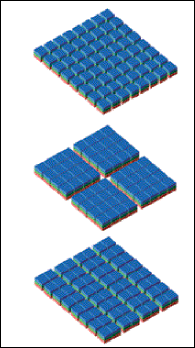
Direct Image Sensor Tackles Color Concerns
Eric Zarakov
When an application demands high-quality color imaging, CCD sensors once were the only alternative, but this is no longer the case for certain applications. Foveon Inc. in Santa Clara, Calif., believes that the key to boosting color imaging capability is with a direct image sensor architecture, called X3, that can capture three colors at each pixel location.
The sensor structure stacks three pixel sensors, or photodetectors, within a pixel location, each dedicated to capturing a different color -- red, green or blue. This produces a full-color image without using a color mosaic filter.
Key issues of note include the following:
Silicon color separation. The X3 sensor architecture plays off the fact that silicon absorbs light of different colors at different depths: blue light near the surface, green farther down and red even deeper. Thus, each pixel location has three pixel sensors at different depths within the silicon to detect the absorption of the red, green and blue light. These sensors convert the absorbed light into three signals that are then converted to digital data and processed with proprietary image processing software.

With variable pixel sizing, Foveon's X3 direct image sensor can vary the size and configuration of a pixel group (2 X 2, 4 X 4, 1 X 2, etc.) to facilitate either still photography or streaming video. Changeover can be almost instantaneous, with no degradation of image quality.
Elimination of mosaic color filters. Currently, most single-exposure CCD and CMOS color image sensors contain just one layer of monochromatic pixel sensors, one per pixel location. To capture color, the pixels are organized in a mosaic pattern resembling a three-color checkerboard. Each pixel location captures just one color out of three, or roughly one-third of the information. The remaining incident light is absorbed by color filters and not used, reducing the efficiency of the pixels.
As a result, sensors must rely on complex processing to interpolate data lost with the colors that are not captured. Interpolation leads to a loss of image detail and to color artifacts. To compensate, some cameras intentionally blur pictures to reduce these artifacts. However, the blur filters reduce artifacts at the expense of resolution and sharpness.
Video performance. The variable pixel size capability of the X3 architecture allows a digital camera to switch seamlessly between still photography and digital video, without sacrificing the quality of either. The feature combines the benefits of large and small pixels in one sensor. The smaller pixels produce sharper images and the higher resolution demanded by still photography. The larger pixels provide the advantage of higher light sensitivity for low-light situations, faster autofocus systems and video applications.
The X3 pixel optimization allows signals from adjacent pixels to be combined into groups and read as one larger pixel. For example, a 2300 X 1500-pixel sensor contains more than 3.4 million pixel locations. But if the variable pixel size capability were used to group those pixels into 4 X 4 blocks, the image sensor would appear to have 575 X 375 pixel locations, each 16 times larger than the originals. Because of the sensor architecture, a blue pixel would be grouped with neighboring ones that are also blue, and so forth.
In a CCD with a mosaic color setup, however, to combine pixels in the frame grabber, it is necessary to group a blue pixel with other blue pixels that may be two or more pixels away. That distance between samples can introduce color aliasing, and complex demosaicing algorithms are then needed.
The grouping of smaller pixels into larger ones increases the signal-to-noise ratio, allowing a CMOS-based camera to take full-color pictures in low-light conditions with reduced noise. The ability to increase pixel size and reduce resolution also allows the image sensor to run at higher frame rates, accelerating the speed of image capture required to shoot high-quality digital video. In addition, because pixel sizing is almost instantaneous, the sensor can capture a high-resolution still photo in the midst of recording video.
Manufacturing costs are also streamlined because the sensor architecture is produced using a standard CMOS semiconductor production line.
/Buyers_Guide/Foveon_Inc/c5152